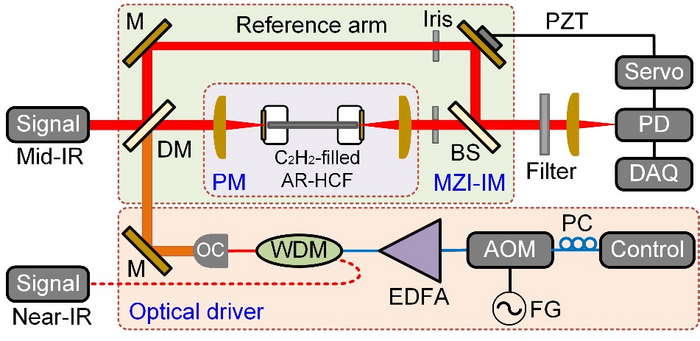Photonics has attracted a lot of attention in the most recent decade because of its potential for producing functioning devices in the near-infrared (NIR) and mid-infrared (MIR) wavelength ranges. Optical modulators are critical photonic circuits that permit signal switching and routing, data encoding, phase-sensitive detection, and spectroscopy. Different substances for NIR modulators have sparked a plethora of research efforts.

Image Credit: Kaiyuan Zheng, Shoulin Jiang, Feifan Chen, Yan Zhao, Shoufei Gao, Yingying Wang, Hoi Lut Ho, and Wei Jin
A group of researchers headed by Professor Wei Jin of The Hong Kong Polytechnic University created a new MIR all-optical modulator centered on an acetylene-filled hollow-core fiber in recent research published in Light: Advanced Manufacturing.
The potential applications for photonics and sensing in this range motivate further investigations of modulator wavelengths in the MIR. MIR modulators have numerous applications, including actively Q-switched laser production, environmental pollution monitoring, chemical and biosensing, industrial process control, multispectral thermal imaging, and early disease diagnosis.
The majority of MIR modulators are built on waveguide-integrated or free-space platforms. Because of their flexible waveguide geometry and complementary metal oxide semiconductor compatibility, on-chip integrated devices have gotten a lot of interest.
Waveguide-integrated modulators centered on thermo-optic, electrooptic, free carrier plasma dispersion, and electro-absorption phenomena have all been established. Most waveguide-integrated modulators are silicon-on-insulator or silicon-on-lithium-niobate platforms, which are mostly used in the near-infrared area due to higher material absorption at longer wavelengths.
Metamaterial, hybrid, and pattern structures are extensively employed in free-space modulators to improve light-matter interaction and produce improved modulation efficacy. The majority of MIR modulators are electrically powered, with external electronics directly applied to the modulation components.
The researchers demonstrated a novel way for achieving MIR phase modulation by utilizing the photo-thermal (PT) effect in an anti-resonant hollow-core fiber (AR-HCF) filled with acetylene (C2H2). The PT effect in gas-filled HCFs has been used to detect ultra-sensitive gases.
The extended interaction distance and near-perfect overlap of the HCF’s pump and probe fields with gas material considerably improve light-gas interaction, allowing for greater phase modulation and hence superior gas sensitivity compared to free-space systems. The researchers expanded the application scope of the PT effect in gas-filled HCFs to include all-optical MIR modulators.
Unlike voltage-driven waveguide and free-space modulators, the PT MIR phase modulators are optically driven in the NIR telecom band by a low-cost control laser. Further evidence for MIR intensity modulation (IM) is provided by integrating the phase modulator (PM) into one arm of a Mach-Zehnder interferometer (MZI).
AR-HCFs have inherent broadband transmission, which, when combined with the short absorption lines of gas materials, allows for the development of ultra-broadband all-optical modulation devices from NIR to MIR.
Journal Reference
Zheng, K., et al. (2022) Mid-infrared all-optical modulators based on an acetylene-filled hollow-core fiber. Light: Advanced Manufacturing. doi.org/10.37188/lam.2022.050.